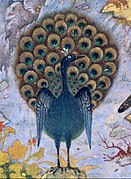The conference of birds

The Conference of Birds ( Arabic منطق الطیر, DMG Manṭiq aṭ-ṭair , literally also "the bird's speech") is a great mystical poem from the Masnawī genre, which is one of the most important works of Persian literature . It was written in the 12th century by the Islamic mystic Fariduddin Attar (1136–1220) from Nishapur in what is now northeastern Iran .
In the one with Maqāmāt aṭ-ṭuyūr ( Arabic مقامات الطيور 'The Places of the Birds') subtitled work is described in the form of a parable according to the doctrine of Sufism, the gathering and pilgrimage of thousands of birds in the world, who are in search of an ideal king for their "people". According to the hoopoe who initiated the journey, this king is the Simurgh bird, who lives behind the mythical Mount Qāf . To get to him, they undertake the arduous journey on which they cross seven valleys - following the steps of the Sufi Path. At the end of the journey, thirty birds are left.
At the travel destination, the birds recognize that they are the king they are looking for: The King's Persian name, Simurgh (سيمرغ), means, written separately, si murgh (سى مرغ), "Thirty birds".
Illustrations
Collection in the Metropolitan Museum of Art , New York. Folio from an illustrated manuscript dated around 1600. Painting by Habiballah of Sava (active approx. 1590–1610), in ink, opaque watercolor, gold and silver on paper, dimensions 25.4 × 11.4 cm.
literature
Text output
- Garcin de Tassy : Mantic Uttaïr, ou le Langage des oiseaux, poème de philosophie religieuse, par Farid-Uddin Attar, publié en persan , Paris 1857. ( Online )
- MJ Maškūr, Tehran 1962.
- Ṣ. Gowharīn, Tehran 1963.
Translations
- Garcin de Tassy : La Conference des oiseaux. Farîd Uddîn Attâr. Traduit du persan par Garcin de Tassy , Albin Michel, Paris 1863 (new edition 1996). ( Online )
- Katja Föllmer: The Conference of Birds . Marixverlag 2008 (German prose translation from Persian).
- RP Masani: The Conference of the Birds: A Sufi Allegory, Being an Abridged Version of Farid-ud-din Attar's Mantiqut-Tayr , London 1924.
- CS Nott: The Conference of the Birds , London 1954, 1961.
- Farîd od-dîn 'Attâr: Le Cantique des Oiseaux, illustré par la peinture en Islam d'Orient. Traduction du persan Leili Anvar. Editions Diane de Selliers, Paris 2012.
Secondary literature
- Edward Granville Browne : A Literary Histora of Persia , London 1906ff, Vol. 2, 506-515. ( online )
-
Hellmut Ritter : The sea of the soul. Man, world and God in the stories of Farīduddīn ʿAṭṭār . Leiden 1955; exp. 1978 edition.
- engl. Translated by The Ocean of the Soul. Men, the World and God in the Stories of Farīd al-Dīn 'Aṭṭār . Translated by John O'Kane with Editorial Assistance of Bernd Radtke . (= Handbook of Oriental Studies . Section 1 The Near and Middle East, Volume 69). Brill, Leiden 2003, 2012, ISBN 9789004244849 .
- Jan Rypka: History of Iranian Literature , Leipzig 1959, 226–229.
Remarks
- ↑ The Arabic noun manṭiq has the basic meaning “place of speaking”, but also means “speech; Language (as a skill); Eloquence; Logic ”(see H. Wehr: Arabic dictionary for the written language of the present , Wiesbaden 1968, p. 866). Nomenطير, DMG ṭair means "bird" and "birds" as a collective form (see ibid. P. 522).
- ↑ The Arabic termمقام, DMG maqām literally means “place on which something rises”, or “place” for short. In a figurative sense, however, in addition to "location, position, station" it also means "location, situation, position, rank, dignity", even in a broader sense, " saint grave, holy place " (cf. H. Wehr, p. 711 ff. ).
- ↑ On the motif in detail: Hanns-Peter Schmidt: SIMORḠ , in: Encyclopaedia Iranica .
- ^ "The Concourse of the Birds", Folio 11r from a Mantiq al-tair (Language of the Birds), The Met



